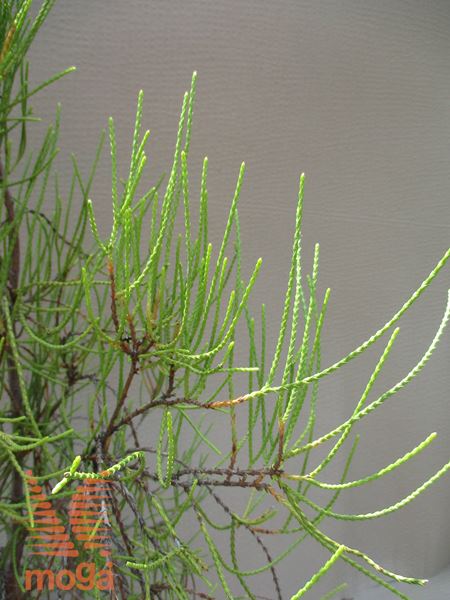Še nimate naše MOGA KARTICE UGODNOSTI
- Registracija
- Prijava
- >Primerjava izdelkov
- Seznam želja (0)
-
 Izbira jezika
Izbira jezika
- Blagajna 0
Vaša samokolnica je prazna
Blagajna
0
Thuja orientalis "Franky Boy"
Latinski izrazi:
Platycladus orientalis "Franky Boy"
Slovenski izrazi:
vzhodni klek "Franky Boy"
vzhodna tuja "Franky Boy"
Thuja orientalis "Franky Boy" znano tudi kot vzhodni klek "Franky Boy" je Srednje velika, pokončna, široka, počasi rastoča zimzelena grmovnica, iglavec (V 1,5-2,5 m, Š 1-1,5 m). Krošnja široko jajčasta. Veje kratke, močno razrasle. Mladi poganjki dolgi, nitasti, nerazraščeni, pokončni do rahlo lokasto povešeni. Iglice goste, luskaste, rombaste do jajčaste (0,3-0,7 cm), usnjate, bleščeče, mlade citronasto rumene do zeleno-rumene, starejše svetlo do srednje zelene. Cvetovi in plodovi manj opazni. Nezahtevna, dolgo živeča rastlina. Potrebuje veliko toplote, bolje uspeva na zavetnih legah. Dobro prenaša mestno okolje, vročino in poletno sušo.
- Te rastline najbolje uspevajo na sončnih do delno senčnih legah. Običajno prenesejo več sonca in vročine, če imajo na voljo dovolj vlage; v delni ali rahli senci so njihove potrebe po vlagi navadno manjše.
- V tej skupini so zbrane rastline, ki so posebno primerne za geometrijsko oblikovane, redno strižene žive meje in jih najpogosteje tudi tako uporabljamo, npr. pacipresa, klek, tisa, gaber, liguster. Praviloma zelo dobro prenašajo redno obrezovanje, so manj zahtevne, odporne in dolgoživeče.
-
Iglavci imajo olesenela stebla (torej debla in veje), imenujemo jih tudi lesnate rastline ali drevnina. Listi iglavcev so preoblikovani v iglice ali luske, pogosto so trdi, usnjati.
- Listi ali iglice ostanejo na rastlini več let zapored, navadno 2-5 let. Zimzelene zelnate trajnice pozimi ohranijo nadzemne dele. V naših opisih te rastline imenujemo zimzelene, sicer pa je zanje pogost tudi izraz vednozelene.
- Rastlina ob primernih drugih rastnih pogojih prenese mraz do -23 °C.
- Propustna ali suha tla so lahka in rahla, vsaj delno peščena, v njih voda ne zastaja, temveč relativno hitro odteče v globlje plasti; takšna tla so bolj zračna in toplejša, a tudi bolj suha in navadno manj humozna, na takšnih rastiščih se pogosto pojavlja suša (npr. skalnjaki, suhozidi, ob poteh, na izrazito sončnih pobočjih, na prodnatih tleh, tudi na gramozni podlagi v naseljih in blizu zgradb...), rastline takšnih rastišč potrebujejo dobro odcedna tla, brez težav prenesejo sušo, ne prenašajo pa stalne mokrote ali celo poplavljenosti.
- Lesnata rastlina, ki je že pri tleh razrasla v več glavnih in stranskih vej, praviloma nima glavnega debla. Krošnja je različno oblikovana, redka ali gosta, simetrična ali neenakomerno oblikovana. Večina grmovnic doseže višino 1-2 m, lahko pa so bistveno večje (do 8 m) ali zelo nizke, tudi polegle.
- Pisani listi imajo vzorce različnih barv, največkrat je vzorec bel ali rumen na zeleni podlagi. Vzorec so lahko črte, lise, pike, obrobe, lahko tudi neenakomerni vzorci ali razpršena barva; različni odtenki lahko postopno prehajajo ali pa so med ploskvami različnih barv ostre meje. Intenzivnost barv in vzorci listov ali iglic na posamezni rastlini variirajo glede na splošno zdravje in stanje rastline, njeno starost, način obrezovanja in oskrbe, močno pa lahko vplivajo tudi vreme, mikroklima, osončenost, tla ter dostopnost vode in hranil. Obarvanost in vzorci na listih se lahko spreminjajo glede na starost posameznega lista ali poganjka in skozi letne čase.
- S to kategorijo smo med opisanimi rastlinami označili tiste, ki so posebno odporne, ne potrebujejo veliko vzdrževanja in so tako primerne tudi za sajenje v javnih nasadih.

MOGA d.o.o.
Družba za urejanje okolja
Zemljičeva ulica 21
2000 Maribor
Slovenija
Sedež podjetja in storitvene dejavnosti
+386 (0)2 4716310
[email protected]
Vrtni center
+386 (0)2 4716313
[email protected]
























